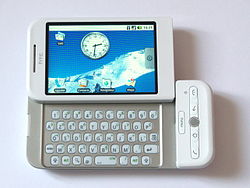 | |
| Also known as | T-Mobile G1 |
|---|---|
| Developer | Google and HTC |
| Manufacturer | HTC |
| First released | October 20, 2008 |
| Successor | HTC Magic, HTC Desire Z (T-Mobile G2), Nexus One |
| Form factor | Slider smartphone |
| Dimensions |
|
| Weight | 158 g (5.6 oz) |
| Operating system | Original: Android 1.0 Last: Android 1.6 "Donut" |
| CPU | 528 MHz Qualcomm MSM7201A ARM11 processor |
| Memory | 192 MB RAM |
| Storage | 256 MB of internal storage |
| Removable storage | Up to 16 GB microSD |
| Battery | 1150 mAh Internal rechargeable removable lithium-ion battery |
| Rear camera | 3.15 megapixel, autofocus |
| Display | 320 x 480 px, 3.2 in (81 mm), HVGA, 65,536 color TFT-LCD at 180 pixels per inch (ppi) |
| Connectivity |
|
| Data inputs | capacitive touchscreen display, QWERTY keyboard, trackball, volume controls, 3-axis accelerometer |
The HTC Dream (also known as the T-Mobile G1 in the United States and parts of Europe, and as the Era G1 in Poland) is a smartphone developed by HTC. First released in October 2008 for $179 with a 2-year contract to T-Mobile, the Dream was the first commercially released device to use the Linux-based Android operating system, which was purchased and further developed by Google and the Open Handset Alliance to create an open competitor to other major smartphone platforms of the time, such as Symbian, BlackBerry OS, and iPhone OS. The operating system offers a customizable graphical user interface, integration with Google services such as Gmail, a notification system that shows a list of recent messages pushed from apps, and Android Market for downloading additional apps. This operating system's debut would later be followed by the Samsung Galaxy i7500, the first in what would become the long-running Samsung Galaxy series.
The Dream was released to mostly positive reception. While the Dream was praised for its solid and robust hardware design, the introduction of the Android operating system was met with criticism for its lack of certain functionality and third-party software in comparison to more established platforms, but was still considered to be innovative due to its open nature, notifications system, and heavy integration with Google services, like Gmail.